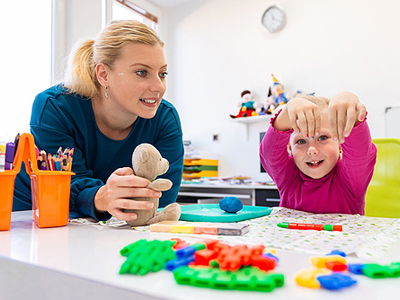-
How Expressive Therapies Can Help Children When Talk Therapy Does Not
- Posted on March 8, 2022
- by admin
- in All Articles, NFSB Blog
- Comments Off on How Expressive Therapies Can Help Children When Talk Therapy Does Not
 People of all ages, including young children and teens, may have difficulty talking about certain topics. When talk therapy isn’t working, expressive therapies may be able to help.
People of all ages, including young children and teens, may have difficulty talking about certain topics. When talk therapy isn’t working, expressive therapies may be able to help.“I like to think of expressive therapies as other languages that can be used in therapy,” said Jessica Hauck, LAC (Licensed Associate Counselor), ATR (Registered Art Therapist) at Nutley Family Service Bureau (NFSB). “All expressive therapies help with externalizing. In other words, they create situations where it’s not necessary to address difficult topics directly. Addressing them indirectly can be just as helpful.”
When children can express their emotions indirectly through activities other than talking about their own experiences, they often feel safer. They may also benefit from a different perspective by viewing a situation from the outside looking in, almost as if it wasn’t happening to them.
If a child seems uncomfortable talking about a particular subject, a form of expressive therapy may be introduced but should not be forced. It should always be up to the client if they engage. Three increasingly popular forms of expressive therapy are art therapy, play therapy, and narrative therapy.
Art Therapy
Art therapy is typically process-focused (the act of making art) or product-focused (the symbolism of the art itself). In either case, the client’s interpretation of meaning is most important.Art therapists don’t make assumptions and should only make assessments based on art that was created in front of them while talking to the client about the meaning behind it. This applies to all forms of expressive therapy.
“I once asked a child to create a family drawing,” Jessica said. “There were a lot of lines and slashes in different colors that made it seem like a stressful situation at first glance. When I asked the child about the drawing, they said it was one of their favorite memories of a birthday party when someone popped confetti into the air. It was a wonderful, stress-free memory. If I were looking at the drawing without talking to the client and observing facial expressions and body language, I may have interpreted it differently.”
Play Therapy
Play therapy can help a child work through worries before they happen. For example, a child who’s nervous about going to the doctor can use play therapy with toy doctor kits. A child will often take the role of doctor and use a stuffed animal as the patient.“Instead of just telling a child that the doctor isn’t so bad and everything will be fine, the child can feel reassured by delivering that same message to the stuffed animal,” Jessica said. “This can help a child open up and talk about certain topics, although addressing the topic directly might not even be necessary.”
In some cases, the therapist will ask a child if there’s anything in the room that they’d like to play with. The therapist will then ask questions that would help the child express their emotions or build awareness while also modeling the appropriate responses for a parent who might be observing.
“Children will often play with puppets,” Jessica said. “One puppet might say ‘I don’t want to play with you’ to another puppet, who will start crying. Instead of a child talking about being picked on in school, this can be addressed in an indirect way. The therapist might ask why the puppet is crying and whether the child thinks what the other puppet said is okay. This approach can help the child come up with alternatives for handling the situation in the future.”
Narrative Therapy
Like art therapy and play therapy, narrative therapy helps the client externalize specific topics so they don’t have to be addressed directly, often through storytelling. In some cases, narrative therapy may show that the issues most important to the child aren’t what the parent or caregiver thinks they are.For example, a parent might tell the therapist that a teen is stressed about grades. In reality, that’s what the parent is most stressed about.
“The therapist might start a story of a boy who wakes up to get ready for school and ask the child to finish the story,” Jessica said. “Instead of talking about grades, the child will tell a story about a boy who’s worried that his friends won’t like him if he doesn’t see them regularly outside of school.”
Again, the underlying cause of stress or worry is revealed without addressing the issue directly.
Gaining Awareness and Seeking Support
Expressive therapies are most successful when a child can use the activity to gain awareness for themselves or share what they feel with family and ask for support.“Expressive therapy can help a child feel heard and understood without feeling pressured to share something in a way that made them uncomfortable,” Jessica said. “Parents may also feel a sense of relief once they gain a better understanding of what was bothering their child. Now they can discuss it and see what else can be done to help the child feel better.”
Please note that various forms of expressive therapy require licensing and highly specialized training. Jessica is licensed in art therapy and has received training in play therapy and narrative therapy. If you’re going to seek out expressive therapies, make sure the therapists you consider are licensed and trained.
If you enjoyed this article please consider sharing it!

















